Let’s start with an impressive number: You only need to speak to 5 users to determine all of your product’s problems. Father of usability Jakob Nielsen found that only 15 user interviews are required, but to better distribute your budget, he recommends holding three study sessions with each of those five users.
The user interview is the type of research organized during any development stage to better understand user wants and needs and consequently - create a better product.
Often, a user interview can be conducted both by a product manager and a designer. The difference is in the intention. While a usability person is concerned with how the user will work with the product, a product manager is seeking an answer to why the user would want the product. These questions are, of course, not mutually exclusive or repetitious.
The task is simple: Sit a person in front of you, find a pen and a notebook (don’t forget the voice recorder to be sure), and begin. Well, not really. Without thorough preparation, picking the right questions, finding the people willing to spend their time chatting about something that matters to them less than to you, you'll probably be returning to your team with empty hands and a mess of tangled thoughts.
User researcher Steve Portigal in his book Interviewing Users: How to Uncover Compelling Insights notes that every expert needs a framework. Indeed, following a custom routine will make a newly introduced concept easier to apply. Here we will share the workflow of our AltexSoft experts. See how they mesh gears with your needs, preferences, or product type. Let’s go.
Step 1. Communicate the need for user interviews to stakeholders
If either you or your stakeholders keep chanting “We know our client already,” this section is for you. Of course, Google Analytics and similar tools give great quantitative data, but it will only tell that there is a problem - it won’t explain why this problem occurs or how to solve it. So, how do user interviews solve problems and what else do they do for the company?
- Help create a three-dimensional user persona
- Transform observations into actionable insights
- Confirm or dispute guesses
- Test a product or MVP
- Help to fix problems before spending time and money
- Develop empathy in all team members
Product management consultant Rich Mironov recommends these tactics to sell stakeholders on the value of user interviews:
Remind stakeholders of the product development efforts. “We actually talked to a few older clients before spending thousands of dollars on the product redesign.” “We’ve previously wasted a lot of resources by skipping this phase.” Fight bias by providing a different perspective on the work done by the product management team.
Be skeptical about unverified product ideas. “How do you know customers will agree to pay for this feature?” “Should we postpone our launch date for this?” “How many users mentioned that they needed this?” When there are no compelling answers, these ideas can be added to the backlog waiting for research and validation.
Celebrate discoveries from user interviews, surveys, and customer feedback. “How cool that we found this promising niche!” “We talked to the client and apparently they are ready to pay for a richer functionality.” “We think sales will be interested in hearing these insights.” Practical examples showcase that hours spent on interviewing users have been paid off.
Basically, leadership bias collapses under the weight of hard evidence and perseverance.
Step 2. Find users to interview
The simple idea of chatting with a (potential) client over a cup of coffee sounds difficult when you try to find a person to chat with. There are a few methods to obtain your interviewers. Sometimes it makes sense to try all sources.
Personal connections. Our friends and family are often the first people we come to with questions. That’s of course when we’re talking about B2C products. Use social media to find users via “friends of friends” and widen the pool. Unfortunately, using this method you can’t accurately segment people by demographics, occupation, or a particular behavior. If you do decide to approach your parents with an interview, remember to plan it just as you would in a more professional setting, which we will discuss in the next step.
Guerilla or street interview. One of the easiest research methods - talking to people on the street - is also the scariest one. People are rushing around involved in the business of their lives or taking a stroll, and each stranger addressing them can be a scammer. However, when you observe how people behave in natural circumstances - waiting for a bus, looking around a store, studying - you obtain information that often can’t be uncovered via conversation. For productivity software, watch out for students and freelancers in parks and libraries. If you want to create a backend app for taxi drivers, ask them how they wish their job would be easier. The key is catching respondents in between tasks, looking visibly bored, or like they're just killing time. Remember that people are usually curious about research and finding out something new about themselves, so mention it right away.
Old or current customers. Depending on the answers you’re looking for, use the database you already have and recruit people who have been using your product for years, or just heard of it, or even left your product for a competitor's. Combine an email campaign with announcements on social media, in your forum or comment sections, incorporate sales and customer support people and offer solution architects to bring it up with clients on regular check-ins.
Paid interviewees. If you have the budget, the fastest method to find targeted users is via paid opportunities. Dedicated sites like Respondent and User Interviews allow you to connect with highly targeted users and manage research activities for a service fee.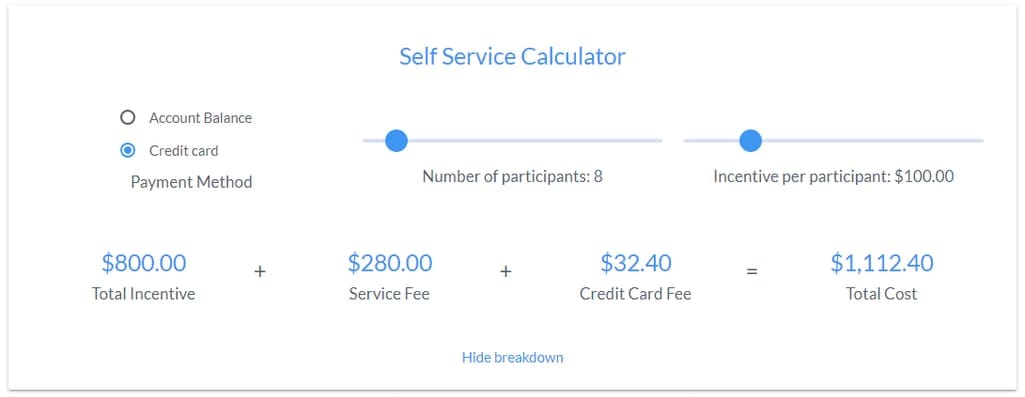
Cost calculator on Respondent
A tool called Ethnio allows you to place a screener on your website or app that targets users in a particular region or with specific purchase history and send them a pop-up asking to take part in an interview.
You can also find users independently and compensate them with a product discount or monetary. If we’re talking about B2B clients, Product Manager HQ recommends providing 1.5x what they make an hour for their time. For example, you want to interview accountants and the interview will take 30 minutes. You know that accountants make $35 an hour. In half an hour they will make $17.50. Offer 1.5x that and the appropriate compensation for them is $26.25, but round that up and offer $30 per person.
Step 3. Prepare the questions and an interview workflow
The way you plan your interview sessions and their deliverables largely depend on your product development stage:
At the start of the project. Before the idea has started accumulating investments and efforts, product management teams are interviewing potential users for their wants and needs.
- What problem do they have or is there a problem at all?
- How do they overcome it?
- Have they used solutions similar to the ones you’re planning to offer?
Remember, that you shouldn’t ask users what they want from the final product - usually, people don’t know they need something until it’s there. This type of interview is for validating the solution (proving that the problem actually exists) and creating a persona.
At the development stage. Here, you already have a sketch of a product to show clients, a prototype or an MVP, perhaps even an alpha version of the software.
- Does the current product have any value?
- What’s missing?
- Does the concept live up to their needs?
At this interview, you show a product model and collect opinions.
After the release. To see how users actually interact with a product, observe them in the right context, record their actions if needed, and ask follow-up questions.
Here, we will list some general recommendations that would fit any interview style.
1. Create a field guide
An interview should be concise and carefully structured - your users wouldn’t want to answer your follow-up calls days after the session. That’s why you need to come prepared with a script. A field guide is your own set of instructions to help you carry out an interview smoothly and without omitting important details. If you’re conducting an interview with a partner (perhaps, a designer), you both will have different field guides. For your own convenience, write a field guide as detailed as possible - prepare the beginning and end of the conversation, give yourself tips and reminders. Edit the guide after every interview until you settle into a working, natural routine. See the example of a field guide below.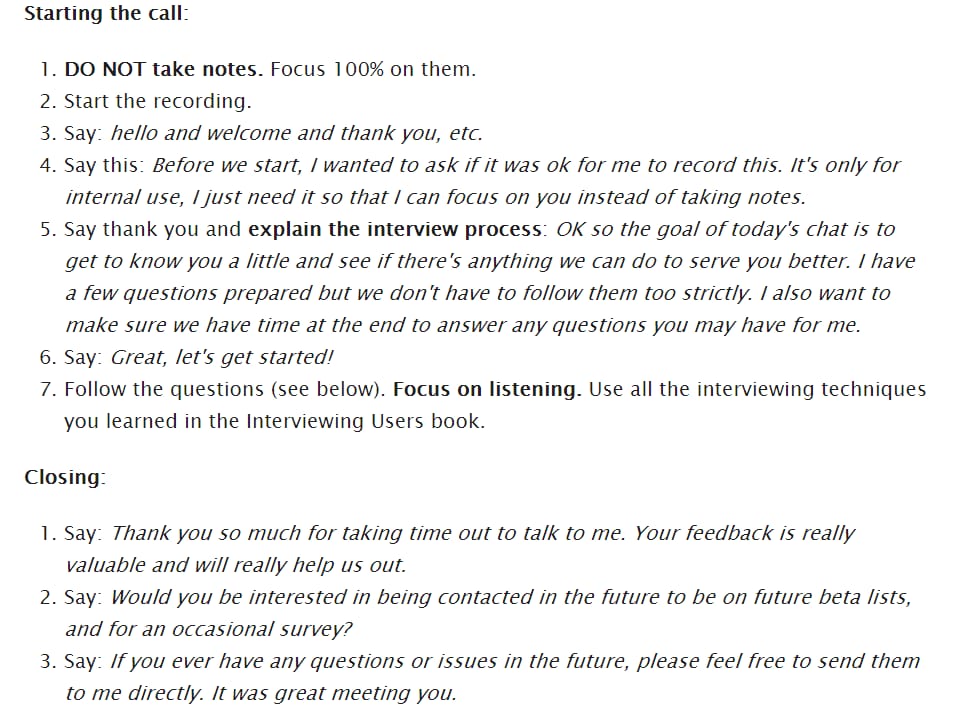
An example of a field guide from Balsamiq
2. Make respondents comfortable
A user interview is something in between interrogation and a friendly chat over brunch. The tone and the setting shouldn’t be too official - a comfortable conference room in your office should be enough, unless, of course, you’re doing a street interview. Some interviews are held in the users’ own homes or offices. Skype interviews are convenient by nature - just remember to ask users to check their connection or move to a different location.
The more comfortable you make the person feel in your presence, the easier it will be for them to open up. People are rightfully uncomfortable when having to discuss the product with someone who’s an expert in the field. To get them to speak their mind, encourage them with reassuring phrases such as “that’s actually a common observation,” “there’s no right or wrong answer, we’re just interested in your thoughts.”
Introduce yourself and give a quick (or long, if a person has questions) rundown of the interview. Tell about the work you’re doing, why it’s important, and why you think they might be able to help you. And of course, ask if they don’t mind that the interview will be recorded - they won’t, but it’s polite to ask.
Ideally, you’re not supposed to make notes; that’s what transcripts of audio recordings are for. Active listening not only promotes better understanding but also make users feel important and heard. Be open about the fact that you don’t know everything and are actively looking for answers in their words. It’s not an examination after all. And, be sure they know that all their responses are valid.
3. Mind their body language
There are two types of data you can gather during user interviews: observed and reported. Reported data is obtained by explicitly asking users. Observed data comes from noticing user behavior that they’re unaware of themselves. Even if you don’t have a product or a prototype yet, you can ask users to show how they currently solve the problem: If it’s an Excel spreadsheet, what tabs they’ve created; if they’re using a competing app, how it works for them. You will most likely notice that they say one thing but act completely differently. You can carefully ask follow-up questions to uncover why they’ve done something, without judging or teaching the better way.
4. Ask accurate questions
Asking questions is a science in itself. Here are a few recommendations for preparing, asking, and analyzing interview questions:
Master probing/follow-up questions. These questions cannot be planned and require some finesse. Use prepared phrases such as “What eventually happened?”, “Was this what you expected?”, or “Can you think of an example?” The simplest probing technique is staying silent. When an interviewee is hanging in the middle of the thought, wait until they finish it and provide more details.
Don’t ask for estimates. Humans generally are not very good at predicting things. Instead of asking “Would you pay $150 monthly for this product?” say “Tell me about how much you paid for a similar solution” or “How much does it cost you to do this manually now?” Same with time estimates. Instead of “Will your employees be able to learn this tool in a week?” ask “How much free time can you allocate every day?”
Use the 5 Whys principle. If a person is struggling to voice their thoughts, reach the root of the problem by asking five consecutive “why” questions.
Do you use a movie subscription service?
Yes, Netflix.
Why do you use Netflix?
It has tons of films and series.
Why do you like watching films and series on Netflix?
They’re HD and I pay only $10 a month.
Why do you think $10 is a reasonable price?
Because I can’t afford renting movies every day but I can afford 10 bucks every month.
Why….?
Here, not only were we able to figure out that a user prefers Netflix to other subscription services - we’ve also established that they agree to pay a sum of money that will overall be less than the cumulative sum for all services.
Avoid closed questions. Questions that can be answered with simple “yes” or “no” waste your time. Not only do they impact a user's attitude towards a topic (“Did you manage well?” “Is it difficult to do this task manually?”), they also prevent people from giving you more valuable information. Rephrase them using templates from Nielsen Norman Group:
Are you satisfied? - How satisfied or dissatisfied are you with this process?
Did it act as you expected? - What would (did) you expect to happen when you ... ?
Does that work for you? - What do you think about that?
Have you done this before? - What kinds of questions or difficulties have you had when doing this in the past?
Did you see that? - What just happened? What was that?
Do you like this? - What would you most want to change about … ?
Prepare for future interviews. Remember to ask users if they don’t mind meeting for a couple more sessions, which are usually held for free. If you’ve managed to arouse a bit of curiosity in them, they will gladly review the next installment of your product and see how their words impacted its development.
Step 4. Extract insights
As we already mentioned, it’s recommended to conduct the minimum of five interviews. Another sign you’ve gathered enough info is when you stop learning new things. If you’ve reached that point, congratulations. Now, let’s learn to store information and analyze what we’ve learned.
1. Create a Topline Report
A topline report is a conclusion to fieldwork, its first deliverable. Suggested by Steve Portigal in Interviewing Users, this high-level document keeps your early impressions, notes, interesting patterns, and correlations. It’s created as if, after each interview, you sat at your desk and dumped all your thoughts onto a piece of paper.
A topline report doesn’t contain any data yet. You start with reviewing recordings, transcripts, videos, screenshots, or any other documents. As you start to notice patterns and identify interesting areas, you may write them down. You can also make bold assumptions about users even if you don’t currently have data to prove them.
Then, you present these observations to your team. It’s important to tell your colleagues that these are just surface findings and they shouldn’t rush for implementation. Upon reviewing the report, team members are encouraged to lead conversations and formulate a vision of a user before the next step.
2. Learn to store and share interview data
Research is best done in groups. Handing the transcript copies to all team members and waiting for innovative ideas may be the easiest but not the most productive thing to do. Besides transcripts, there are always written notes, mental observations, maybe even screenshots, screen recordings, or videos. How to effectively keep all that data to then share with a team?
One of the most popular collaboration tools is Confluence. It allows you to create documents using different templates, layouts, and styles. Create a page about each interview participant. Give your team members the overall context by describing a user’s occupation, company, and relationship to your product (prospective customer, past user, a long-time client). Don’t forget about use cases, problems uncovered during an interview, and other takeaways. Add tags, labels, direct links to attendees, upload recordings, transcripts and more. In the section about observed problems, remember to include quotes with participants’ direct words.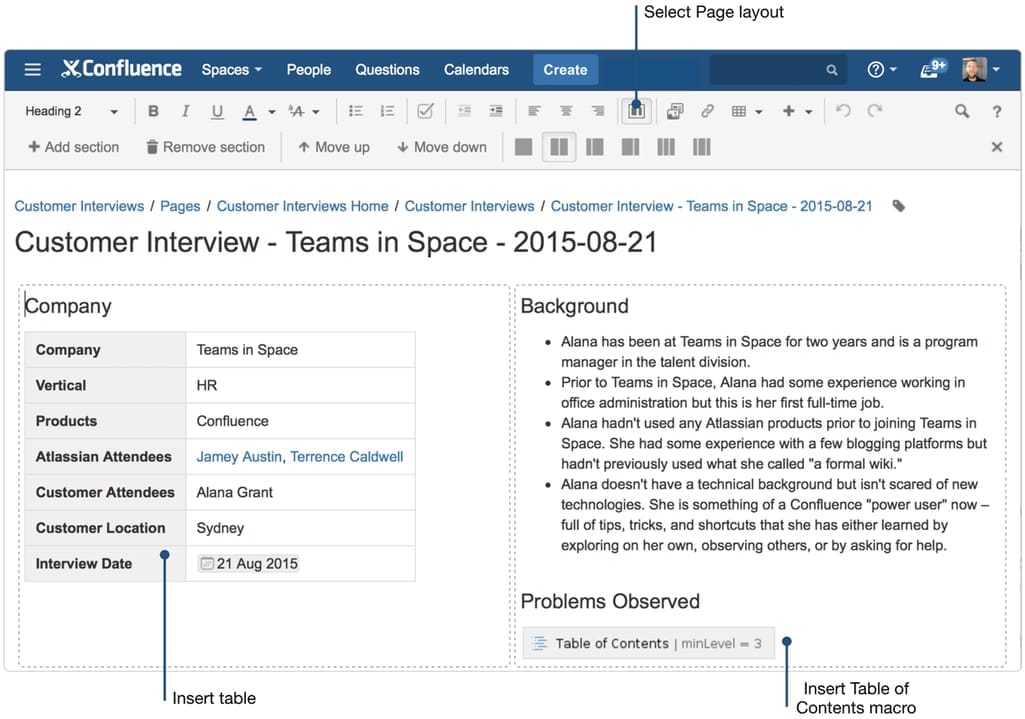
An example of a Customer Interview page in Confluence
There’s also a simple yet useful method called The Rainbow Spreadsheet, created by the Google Search UX researcher Tomer Sharon.
Using The Rainbow Spreadsheet requires some preparation: First, you have to learn to use it before holding an interview, and second - you must schedule 45-minute breaks between the interviews to gather your thoughts. In the spreadsheet, you collect details of your participants including their age, occupation, company, etc. Then, you fill in the sheet with predetermined observations, that is behaviors you expect a user to demonstrate: “Switched to the History tab when asked to view past payments.” There, you also collect your metrics. Then, during an interview, a researcher or an observer makes changes to the document depending on a participant’s successful actions.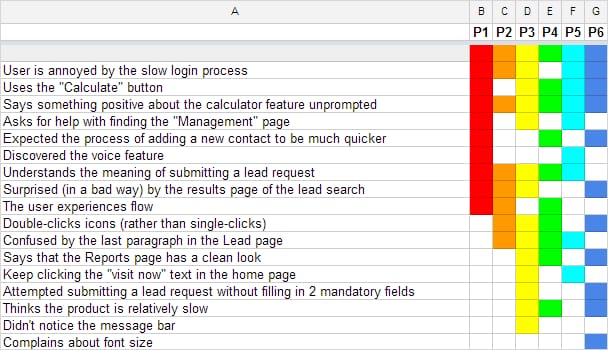
An example of The Rainbow Spreadsheet where column A is predetermined observations and columns B-G are color-coordinated participants
As this method is meant to be used live or with recordings, it won't be helpful for field studies or when documenting unexpected observations. However, it’s highly customizable: You can add as many sheets as you like, use it during or after an interview and with any team size.
3. Deeply process your data
After the team is introduced to the high-level information, engage them in data processing. Have each person carefully go through transcripts, making notes, noticing patterns, or even offering first solutions. Then, have them present each interview as a case study or a user story. As we have explained in our functional and non-functional requirements article, a user story is how a user would describe a feature.
Write the highlights of presentations along with user stories on separate sticky notes and stick them onto the board. As you go through all interviews and gather tons of sticky notes, rearrange them by patterns: user personas, features, opportunities, etc.
As for alloting time, be prepared to allocate a week or so for analysis, similar to the Design Sprint. Skimming through interview transcripts that usually occupy a few dozen pages should take a few hours, and then assign an hour for each interview presentation.
During those analysis sessions, you should end up with your main research deliverable - Presentation of Findings.
4. Share user research results
The Presentation of Findings that you managed to conclude has to be, well, presented. What is the best way to do this?
Regular presentations. Stakeholders best speak the language of presentations and often, it’s our best tool to communicate what we’ve found. However, no presentation will impress people unless it has examples, direct quotes, user stories, or even videos to engage the audience in the discussion. It’s best combined with some of the other methods listed below.
Personas. This is a fast and effective way to make stakeholders relate to the user. They are useful for telling user stories and justifying solutions (“Jane doesn’t have time to manually check her colleagues’ calendars to schedule a meeting”). Personas are not supposed to be the exact people you interviewed during research but you’re welcome to use quotes and exact use cases from them.
User journey maps. Explained in our UX vs. UI article, a user journey illustrates the sequence of actions taken by a person when using the product. It’s created on the basis of customer needs, wants, requirements, and problems, and thus perfectly illustrates how data from an interview can help create the structure of the product.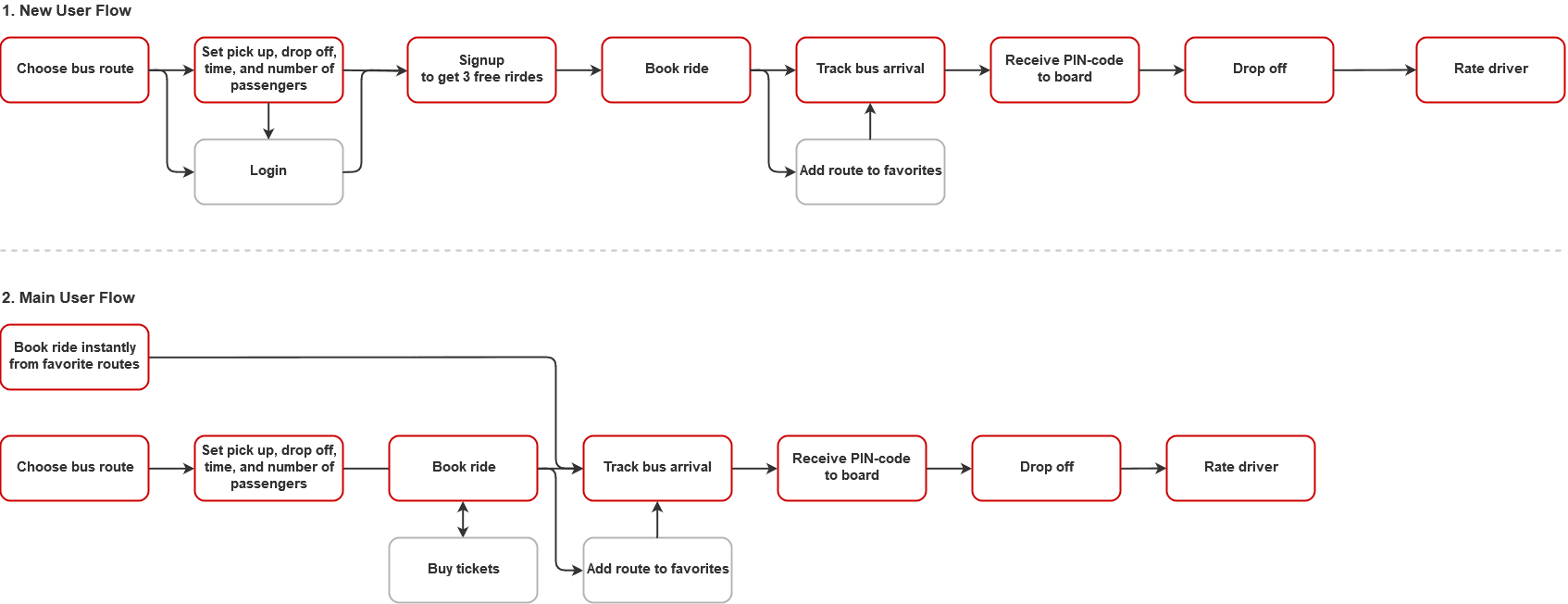
User journeys for new and returning clients created by AltexSoft for Niftie
Storyboards. This method uses storytelling as an effective tool to illustrate the problem (or solution) in a fun and engaging way. It uses photos, drawn pictures, graphic design elements, or even sounds and gifs to share failed or successful experiences and draw an emotional response from the audience.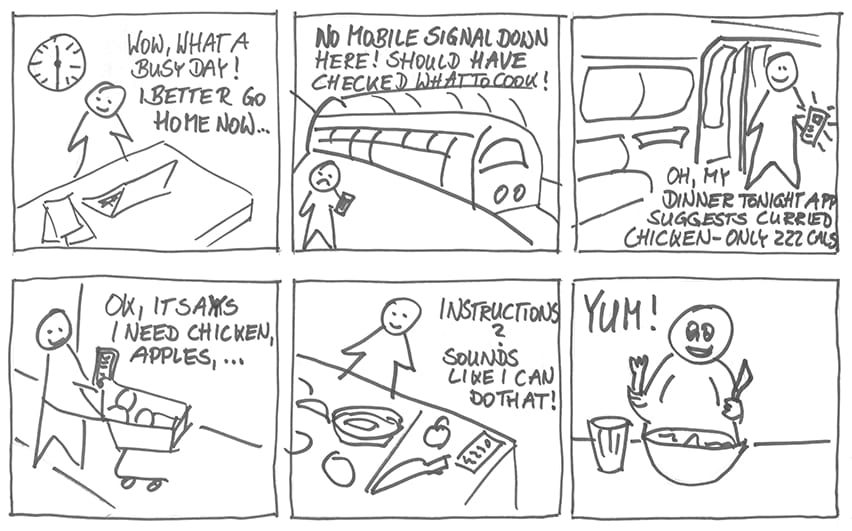
A storyboard for a recipe app Source: Vizteck
Mini-museums. When the volume of gathered data is overwhelming and you can’t seem to cram everything you know into one presentation, consider creating a mini-museum of your findings. Facebook does that and it seems to be the most fascinating sharing method. Gather the whole company in a room and allow them to interact with data. While many employees don’t need to learn as much as you do about customers, they might feel more inspired, get some of their questions answered, and collaborate in discussions in a less official setting than, let’s say a presentation.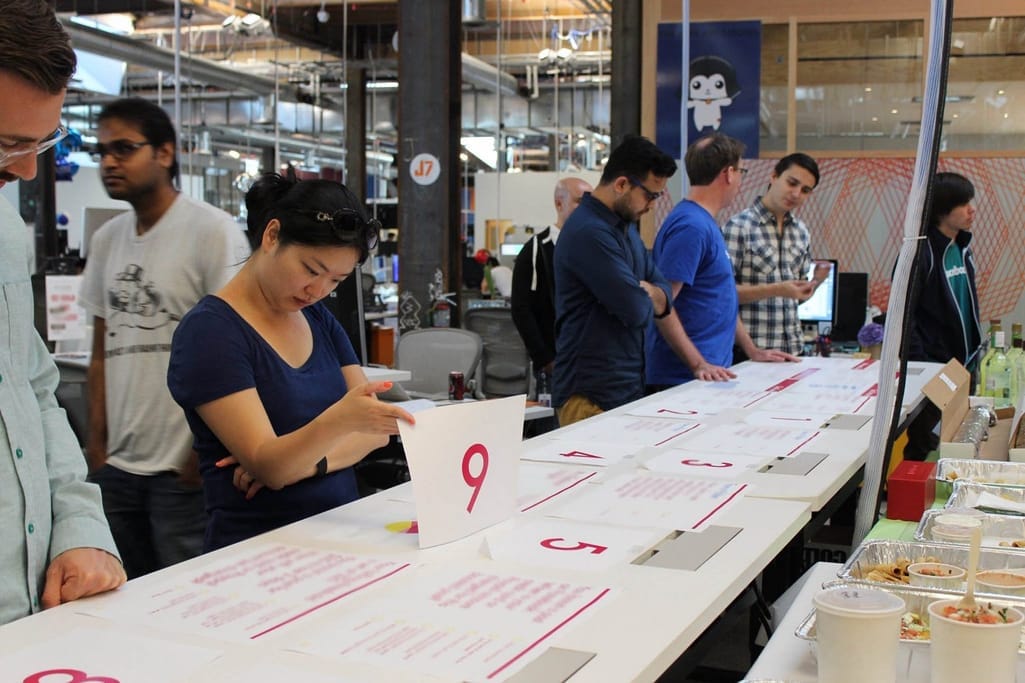
A mini-museum at Facebook
Interactive workshops. Even when people are praising your work and have enjoyed the presentation, they won’t necessarily put all this new knowledge to work. To make stakeholders feel responsible for bringing findings to life, consider workshops. Workshops are harder to organize, they take more time and effort on your part, but when done right, it can shift the whole attitude towards research and the actions that follow. Start with simple brainstorm games and continue onto sketches, role-playing, and more. Make sure to read our article about conducting effective product development workshops, if you’re interested.
Final word
Learning to construct accurate questions and plan effective interview sessions is an iterative process. Embrace your mistakes and rewrite your field guide before each conversation before you end up with your very own framework. Let’s sum up our main recommendations:
Less is more. Employ a minimum number of people for interviews and hold repeated sessions with them to find deeper, truer, and more valuable insights.
Stay persistent with stakeholders. The quality of a product is directly influenced by the quality of interviews, so stand your ground when sharing this value with people interested in the result.
Master the art of asking questions. Recognize that you’re more interested in people’s answers as they are and learn to overcome any block with psychology tricks, smart conversation techniques, and thorough planning.
Share knowledge. There’s no use in knowing your client if only one small group of people holds this knowledge. Show your findings to anyone who may be interested in the final user, either for information or motivation.
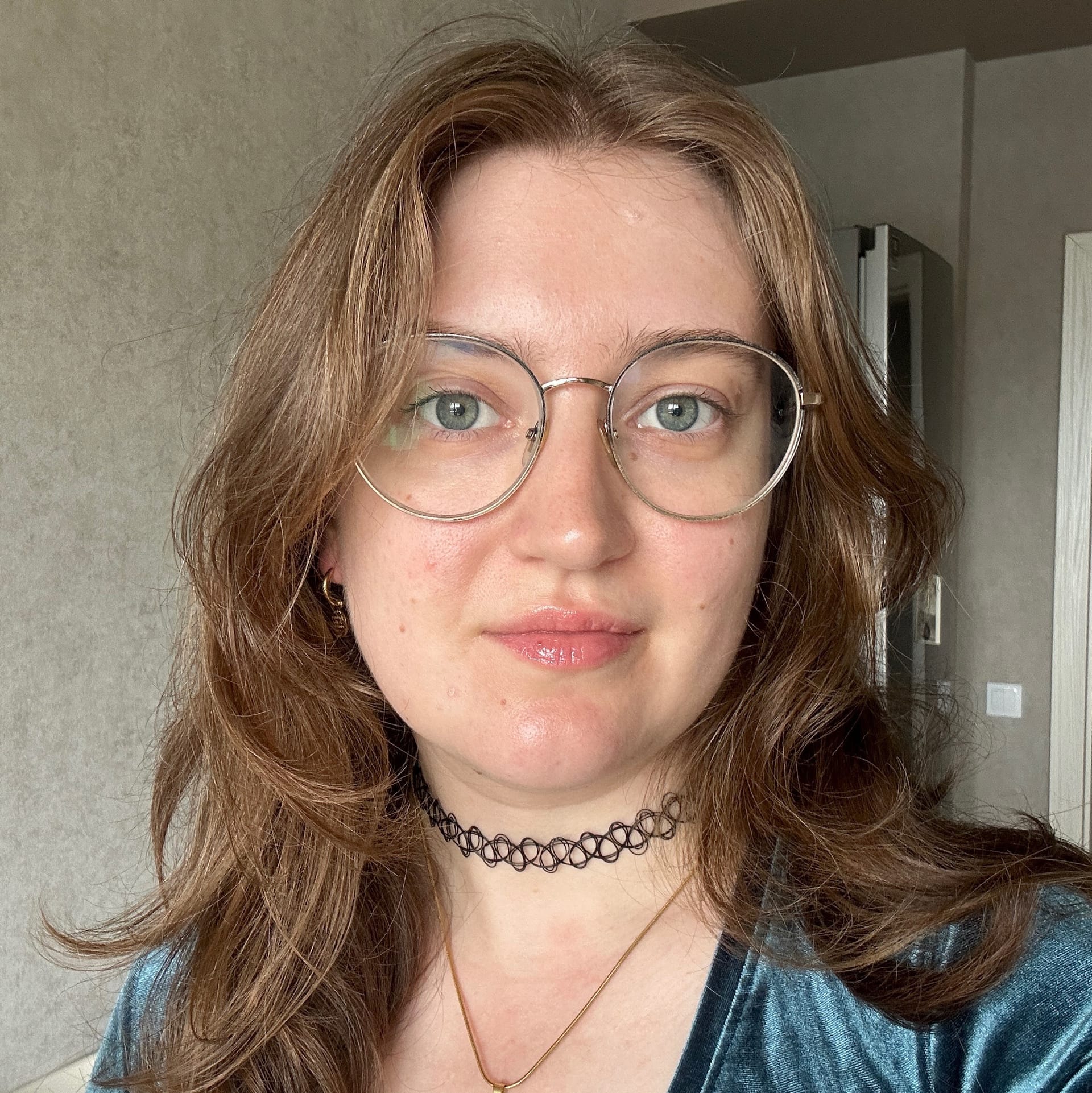
Maryna is a passionate writer with a talent for simplifying complex topics for readers of all backgrounds. With 7 years of experience writing about travel technology, she is well-versed in the field. Outside of her professional writing, she enjoys reading, video games, and fashion.
Want to write an article for our blog? Read our requirements and guidelines to become a contributor.

